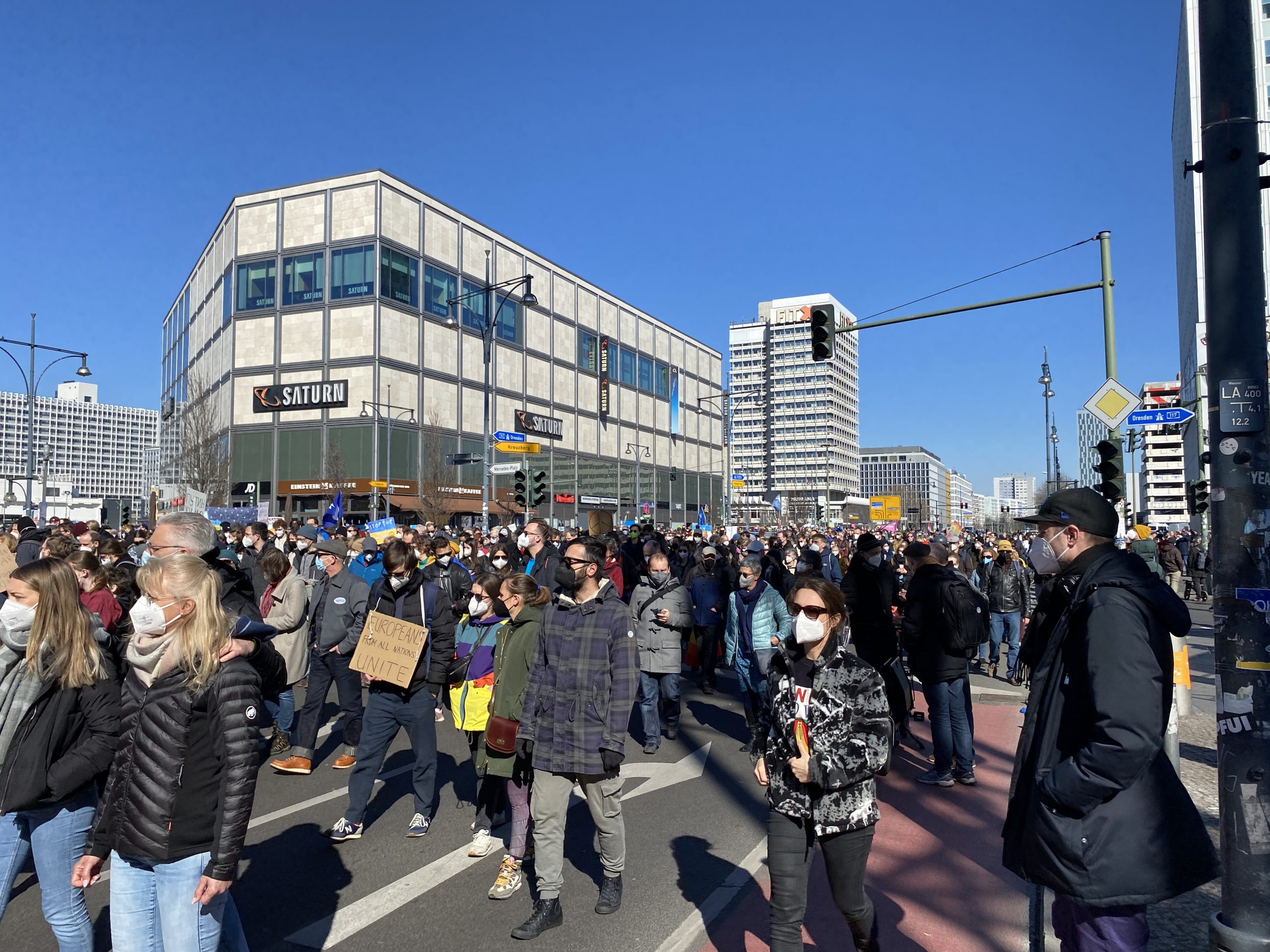Ukrainian Humanitarian Crisis – When Will EU Solidarity End? – Agnieszka Weinar

Protesters in Berlin, Germany express their solidarity with Ukraine amid the Russian invasion of Ukraine. Photo courtesy of Martin Geiger
Four million Ukrainian escapees [1] came to the European Union within five weeks of the Russian invasion, with daily numbers reaching over 100,000 per day in the first two weeks. Such flow is unprecedented – at the height of the Syrian crisis in 2015, the EU saw 10,000 crossings per day. At the same time, the reaction to this wave has also been unprecedented, with the EU evoking a long-forgotten Temporary Protection Directive and all Member States agreeing not only to implement it but also to set up some form of internal burden-sharing – all in merely a couple of weeks. Central and Eastern European countries stepped up their reception capacities, with governments allowing the people to take action and welcome those fleeing the war.
Such human flows pose serious risks to the longer-term stability of the region. All lies in a delicate balance between the goodwill of people and politicians and the socio-economic reality of the prolonged conflict. Can the European Union stand with Ukrainians?
Factors going for Ukrainian escapees include the following. 1. Legal clarity. Ukrainian escapees have few advantages over other asylum seekers in Europe: they do not need a visa to enter the Schengen area, so they do not need to ask for asylum to be let in; they do not need to go through a safe third country to get to the Schengen border; because they do not enter as asylum seekers, Dublin Convention does not apply to them – it means that they do not need to stay in any procedure to move around Schengen; the temporary Protection Directive gives them the right to remain and work in the EU for up to three years. In part, it was applied to recognize that the Ukrainians are using their mobility rights in any case and need to be traceable by some unified system. 2. Social acceptance. Ukrainians have found a warm welcome in the EU, in part because they form a part of the larger European family of nations. However, other factors have also been at play: Ukrainian evacuees are primarily women, children, and the elderly (ca. 95%). This demographic falls squarely within the European historical experience with war, and thus media reporting evokes atavistic subconscious reactions. After all, countless generations of European families knew the drill: women, children, and the elderly flee to safety while men return to fight; Ukrainians have the largest immigration network across the EU, with millions engaging in circular migration for decades before the war. On the one hand, transnational ties now support the escape: many families came to stay with relatives in the first weeks. As an additional perk, many Europeans personally know a Ukrainian: this makes the ties more meaningful; and Ukrainians flee a threat that feels very real to millions of Europeans: bombs falling 10 kilometers from the EU border, and the perpetrator is Russia, the historical butcher of the nations East of Berlin (Berlin included).
Factors undermining European solidarity include the following. 1. Duration of the war. This is the most critical factor. EU solidarity was activated on the expectation that the war would end in a few months. As this outcome seems less and less likely, the following factors will occur and play a crucial role in destabilizing the EU’s response to the crisis. 2. Russian propaganda. Russian disinformation has had some spectacular wins during the Syrian refugee crisis and later during the battle for Aleppo and Idlib. Russian trolls skillfully dehumanized Syrian refugees and framed them as rapists and terrorists. They are still struggling with the right angle to turn the tide of solidarity with Ukrainians – after all, it is difficult to sow fear in the face of nearly four million women and children. Until now, the only successful narratives that have emerged were those that try to install self-doubts in the EU response, such as the popular narrative of “white privilege”, which disregards the salient legal, geopolitical, and social facts. However, the longer the war lasts, the more fake news and skewed narratives will emerge. 3. Social burden. The escapees are primarily single mothers. This is not exactly the best material for flexible workers EU needs. Immigrant single mothers are the most vulnerable category of migrants, with substantial social security needs. For the moment, the Ukrainians are in limbo between the hope of return and the fear that the return will not be possible. If the war lingers on, likely, many will not integrate the labour market well, posing important integration and social cohesion problems in the long run.
The EU put its bets on a short war, which might not materialize now. A prolonged conflict will most likely bring an end to European solidarity.
Endnotes
[1] I do not use the term “refugee” on purpose, to underline the different legal status of Ukrainian citizens who escape the war. Most are not covered by the Geneva Convention on Refugees and use a special set of laws allowing them to come and stay in the European Union.
~ Agnieszka Weinar
Adjunct Research Professor, Institute of European, Russian and Eurasian Studies, Carleton University (agnieszka.weinar@carleton.ca)